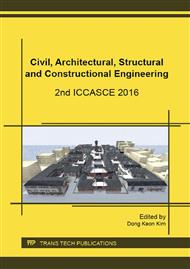p.15
p.22
p.29
p.34
p.38
p.44
p.50
p.57
p.61
Effects of Connecting Plates on Cold-Formed Steel Wall Plate System
Abstract:
The paper presents experimental investigations on cold-formed steel (CFS) wall plate system. The behavior and the modes of failure of the system under uplift were studied. The parameters tested were the presence of gaps and the thickness of connecting plates. Results showed that samples with and without gaps at the supports experienced the same failure mode. Failure began with the yielding of connecting plates followed by the buckling of C-channel. Similar ultimate capacity was also obtained for samples with and without gaps. When connecting plates of different thicknesses were used to connect the wall-plate, different modes of failure were observed. Instead of yielding in the connecting plates, screw pull-out was observed in the connection before the C-channel buckled. Besides, it was observed that the ultimate capacity of the system was reduced when thicker connecting plates were used. It is not conservative to estimate the capacity of screwed connection according to the design standard and it is proposed that the capacity of the wall plate system is taken as the yield capacity of the connecting plates of the same material properties.
Info:
Periodical:
Pages:
38-43
Citation:
Online since:
November 2016
Authors:
Keywords:
Price:
Сopyright:
© 2017 Trans Tech Publications Ltd. All Rights Reserved
Share:
Citation:


